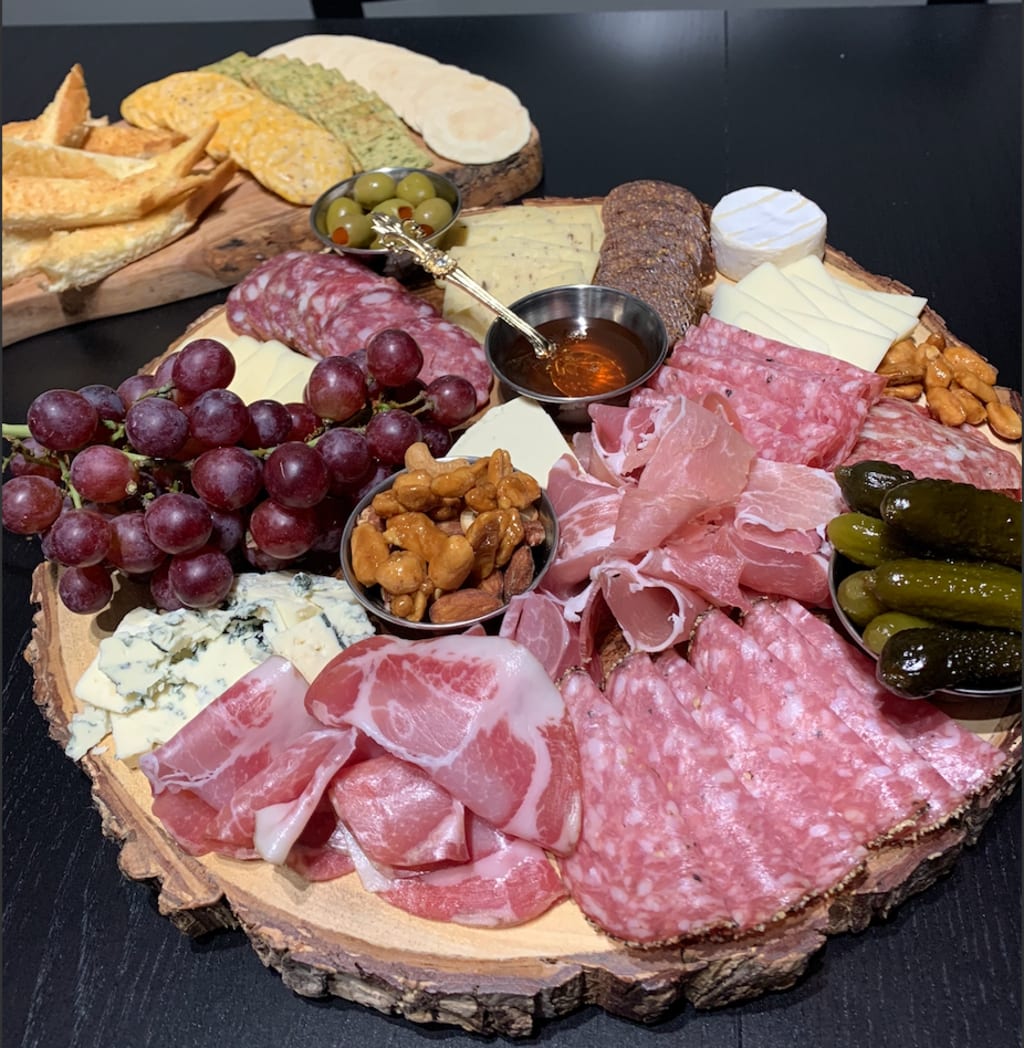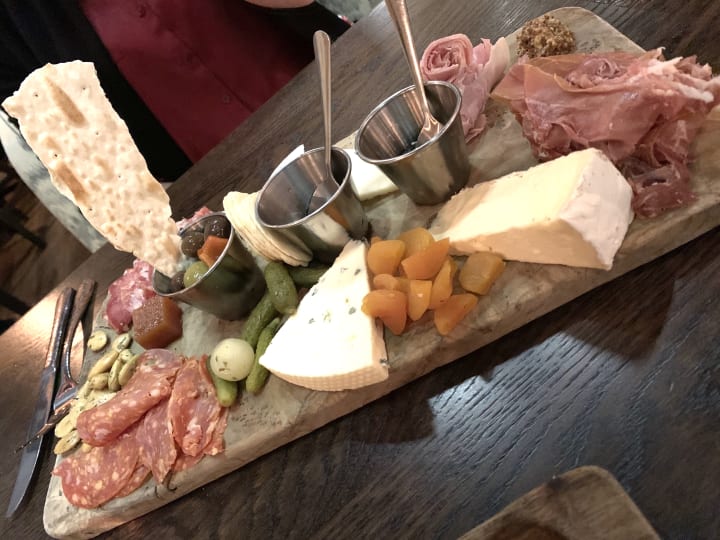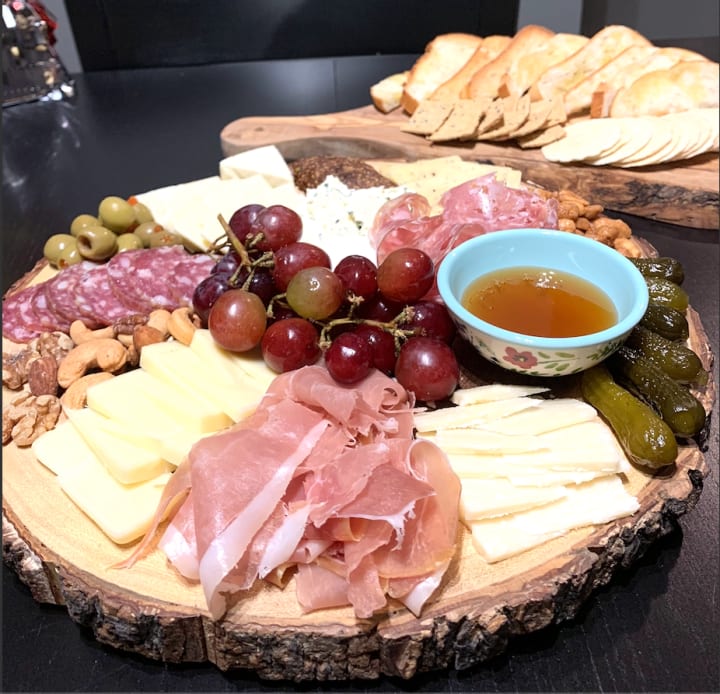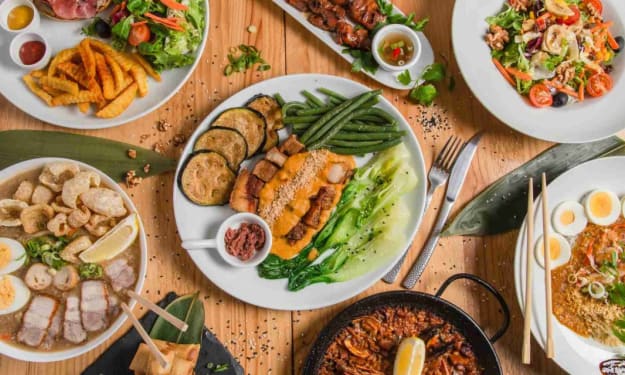How To Make An Epic Charcuterie Board in 10 Steps.
How to Charcuterie.

Charcuterie (pronounced "shahr-ku-tuh-ree") is the art of preparing and assembling cured meats and other meat products.
This is a guide to making your charcuterie dreams come true. Better than anything you could ever get at a restaurant.
Charcuterie is an art, a craft. A board to show off taste with a touch of class. A board to be shared and enjoyed. The beauty of charcuterie is there are endless options to pick to make a chacuterie tray. All up to everyone’s selection. No perfect board or right way to make it or design it. It’s a blank board ready to be crafted however you would like. Able to be filled with the creativity of the craft or the ingredients you choose. Endless possibilities and combinations.
With a charcuterie board, a little bit of everything is never a bad thing and highly encouraged especially when making a board for more people. Charcuterie is what you make of it. Quality and effort are two things that shine through when presenting a board such as this to others.
Be sure that especially the meat and cheese you get is good quality over quantity. It’s not a dish meant to be eaten in bulk as people usually just sample and get small amounts remember that. Wanting to savor every bite and have a new experience as they taste each different facets of the board.
Variety. Balance. Presentation.
Charcuterie quality is more impressive than charcuterie quantity.

1. Find your perfect board.
Whether it’s a circle or a elongated style rectangular board. With a handle or without. Slices of natural wood or off colored wood boards always make really beautiful foundations for a impressive charcuterie. Use wood for a trendy and rustic look. For an upscale aesthetic and modern feel, slate servingware is a good option.
The board should be fairly big as you want to make sure it can fit an assortment of different types of items. You do not want to have to overlap flavors or squish the board tarnishing the appearance because of lack of room. You can always spread things out if you're left with more room versus running out of space. A good sized board with character is a must.
Every part of the charcuterie is important as it makes up the whole concept of a good charcuterie and it starts with the foundation.
You can use a separate board or bowl for the "carriers" as they don’t need to be on the same board taking up important space for the main parts of the charcuterie.
Presentation is everything in what makes charcuterie such a popular and delicacy for entertaining and sharing.
2. Decide what you want on it.
It’s important to have a variety. You want a blend of flavors from sweet to salty to spicy to crunchy to soft to savory. The balance of fatty and leaner meats and cheeses you’d like. Consider the coloration and flavors that you wish to make up your board. These things can helped you determine what items to choose in each type of food you need to choose for the parts of your board. For example, choose different colored fruits other than just darker colored ones like red grapes and red apple slices and berries if you want a darker board matching a dark wood board versus adding more colorful fruits to add color.
Balance is key to having a board that is equally as impressive as it is tasty for everyone’s taste. Impress by sight and by taste. A balance of flavors between all the components on the board of rich, sweet, salty, spicy, mild, cold, delicate, smoked, dry, hard, aged, crunchy, soft, and creamy. You want to convey different flavors, contrast, textures, and aromas. These can come from different parts of the charcuterie up to your discretion.
Remember charcuterie is meant to be a sophisticated and complex dish. It is not a singular dish in any way or fashion. Every part of it is meant to be different.
It's important to consider all of the flavors of the things you choose to make sure not to overpower any of the flavors and complement others. It's not essential to have all the flavor profiles mentioned but necessary to have a few that oppose and complement each other. Add some accents to add character to your board such as things discussed below other than just meat and cheese.
Be sure to balance any strong flavors with more mild options. Spicy with sweet. Fresh flavors with aged ones. Dry with soft. Fattier with leaner. Crunchy with savory.

3. Choose your meats.
These should be cured meats. Choose a variety of meats such as Coppa (cured pork shoulder), Serrano (Spanish ham), Prosciutto (Italian ham), Salami (cured pork), Soppressata (Italian Dry Salami), Pepperoni (American Salami), Chorizo (spicy Spanish Pork Sausage), Spec (smoked prosciutto), Mocetta (cured beef tenderloin), Lardo (cured pork fatback cured with herbs), and so on. There are many options with these core staples for a board in terms of whether you want soft or hard versions of the meats. If you choose sweeter, spicier, infused, smoked, or more peppered versions. Thinly sliced or thicker sliced. From many different counties or origins. There are almost stuffed options that you can select to have on your board such a proscuitto or pepperoni and monzarella fingerlings.
4. Choose your cheese.
Cheese is much like meat in that there are so many different kinds and ways they are made. It’s good to have a variety of textures and flavors of cheese such as a Brie, Blue cheese, Cheddar, Truffle cheese, Chevre (Goat), Swiss, Monterey jack, Gouda, Parmesan, and Pepper jack. There are many versions of these cheese out there than just the kind you normally associate with the names. Aged, moldy, sharp, soft, bold, infused, firm, semi-soft, creamy, smoked, crumbly, or even peppered with a variety of different colors of cheese such as cheddar. Sliced, shaved, or even cubed, more blocky cheese. Or even small mozzarella balls. To present as triangular chunks or in smaller amounts. Be sure to include a spreadable cheese such a Brie.
5. Choose your fruit.
Fruit is a important part to a charcuterie to help accentuate, add color, and sweetness to a board. Typically berries, grapes, and apples are commonly found. Mainly red grapes are sweeter accompaniments are good rather than sour in the fruit department for a tray like this. Dried fruits such a apricots and dates also are sometimes used to add a sweetness to the board. Specifically, sliced apples, strawberries, blackberries, strawberries, and raspberries are popular options.
6. Choose your nuts.
Nuts add a nice crunch to boards and other hints of other flavors depending on if they are coated in anything. Have at least a salty one and a sweet one. For example, mixed nuts and honey roasted nuts. Or maybe some unsalted almonds or more savory nuts like rosemary nuts or even sweet like cocoa dusted almonds. You can also add a spicy mix of nuts. Crunchy chick peas that are lightly dusted are a unique choice for a board as well. Any nuts whether peppered, dusted, blanched, salted, glazed, or coated are sure to be great additions to your charcuterie board.
7. Choose your pickled veggies.
Pickled veggies rather than fresh ones offer a differing element to a charcuterie tray. They also add character and a differing flavor for the pallate to help build a more complex flavor profile. Pickled veggies pair well with meats.
Olives. Tiny Pickles. Peppers. Carrots. Red onions. Sweet, sour, or spicy.
8. Choose your crackers & breads.
You want things to hold and carry the charcuterie components that aren't going to bread or get soggy. Bread or crackers. Plain, buttered, flavored, seasoned. It's good to have a mix as not everyone likes crackers, bread, pretzels, breadsticks and some like a more plain option to be able to taste the flavors more of the items they choose from the board. Whether they are from Italian bread, baguette, wheat, flax, spinach, matzo, or another grain. Water, multigrain, cheese flavored, and bagel chips are good cracker choices. Bread sliced diagonally, triangular, or straight down. Toasted, oiled, or served soft and plain.
9. Find some tiny bowls, jars or metal ounce containers & classy, cute serving utensils.
Adding these utensils and dishes helps with presentation and serving. For separating, spreading, serving charcuterie as well as tiny spoons for drizzling things like honey and mustards. It’s good to add a side of honey and/or some jellies as they are excellent garnishes for stacked charcuterie snacks. Jellies can also be slathered on a part of board if you prefer or presented like a palate next to each other. You can also separate nuts, veggies, and fruit in these.

10. Choose your arrangement and how you want to present your board with its design.
This is where you are design your masterpiece in your image. This is the most tedious part and where placement is important to creating the charcuterie you have always imagined.
Design and arrangement choices like alternating meats with cheese. Placing them symmetrically. Accentuating parts with things to garnish like fruit, herbs, veggies, or nuts. To fold or not to fold or even to roll the meat. To kebab meats and cheeses together or leave separately. How to cut your cheese. To cut everything or just a few things leave some to be sliced. To curve or diagonally lay. To arrange segmented or in a circular design. How to stack it or slant it. To separate fruits and veggies or infuse them into the board placing them throughout. To use quadrant placement and segment or not. Where to put everything on it. Whether you want a more organized board or one that is more sporadic and random looking.
You may consider adding squares of palate cleansers for when people are switching flavors and wish to cleanse their palate.
Garnish with some fresh italian herbs for color.
The beauty in charcuterie is that it is what you make it and every board is different! There are endless options and ways to create it.
Charcuterie is meant to be a classier, more detailed dish. The novelty and appeal is in the appearance of it which is found in the balance of items making it up, the balance of colors, and the presentation of those things.
The craft of creating a good charcuterie board is a skill sure to benefit you at the next party or gathering you go to leaving everyone talking. Everyone loves a good charcuterie board. One that not only tastes good but also looks good.
Cheers to you becoming the best charcutier you can be.
Don't forget to take a picture and enjoy!

About the Creator
M F
Your Feelings Are Valid Author. Chainsmokers and Fletcher fanatic. Quote lover. More emotional than your typical Capricorn. TPA. ISTJ. Lesbian. Asian.
Insta: @garnishdaddy. Owner of Native Cocktail Events







Comments
There are no comments for this story
Be the first to respond and start the conversation.